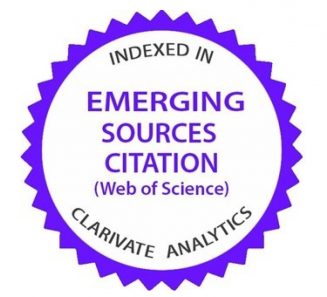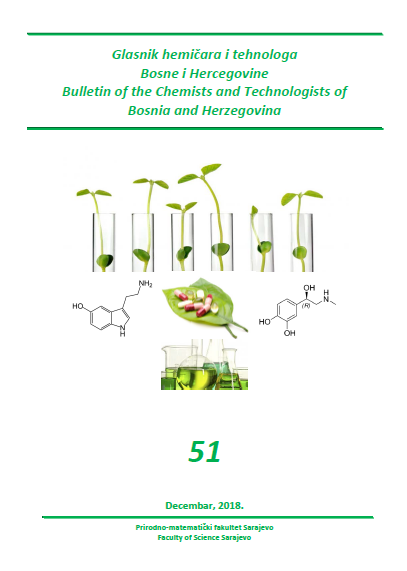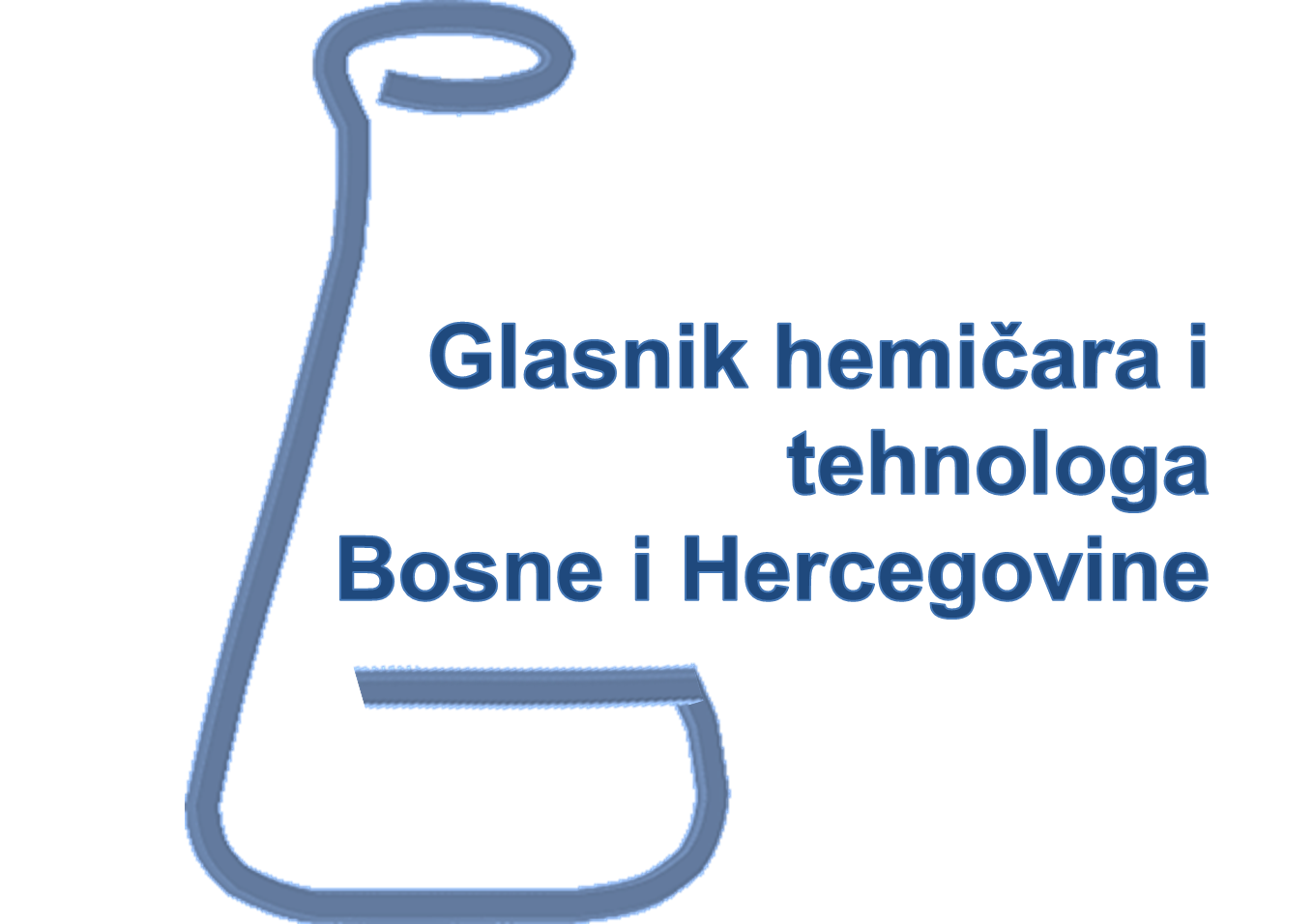|
|
Bulletin of the Chemists and Technologists of Bosnia and Herzegovina
Issue 51
Publication date: December 2018 |
|
Table of contents
Synthesis, characterization and in vitro antimicrobial activity of the Cu(II) and Fe(III) complexes with 1-cyclopropyl-6-fluoro-4-oxo-7-(piperazin-1-yl)-1,4-dihydroquinoline-3-carboxylic acid Original Scientific Article
Horozić Emir, Cipurković Amira, Ademović, Zahida, Kolarević, Lamija., Bjelošević, Demir, Zukić, Amila, Hodžić, Snježana, Husejnagić, Daria, Ibišević, Merima
Abstract: 1-Cyclopropyl-6-fluoro-4-oxo-7-(piperazin-1-yl)-1,4-dihydroquinoline-3-carboxylic acid (Ciprofloxacin, CFL) is a drug that belongs to the second generation of fluoroquinolone antibiotics with a wide range of effects on Gram-positive and Gram-negative bacteria. The bactericidal action of ciprofloxacin results from the inhibition of the enzymes topoisomerase II (DNA gyrase) and topoisomerase IV. In organism there is a possibility of interaction of CFL with biogenic elements in the blood, which could lead to the formation of complexes. This can cause change in the activity of antibiotics towards pathogenic microorganisms. The aim of this work was to investigate the interaction of CFL as ligand with the biological cations Cu(II) and Fe(III) in physiological condition. Synthesized complexes were characterized using IR spectroscopy and stereo-microscopy. Antimicrobial screening was performed on bacterial strains of Escherichia coli, Enterococcus faecalis, Staphylococcus aureus and Salmonella Enteritidis. The results of IR spectroscopy showed that the Cu(II) and Fe(III) complexes with CFL were formed through the oxygen donor atoms of carboxyl and carbonyl group of the ligand. The color and size changes of the crystal of the ligand and complexes were also clearly seen. Antimicrobial screening has shown that CFL and CFL complexes have similar antimicrobial activity against all tested strains. The Cu(CFL)2 complex showed better antimicrobial activity compared to the Fe(CFL)2(H2O)2 complex.
Bulletin of the Chemists and Technologists of Bosnia and Herzegovina 51, 1-6.
Influence of tested parameters on biodiesel quality obtained from used and unused vegetable oil Original Scientific Paper
Nuhanović MIrza, Memić Semir, Sušić Edita, Smječanin Narcisa
Abstract: The aim of this study was to obtain biodiesel, synthesized by transesterification from used (waste) and unused (industrial) sunflower vegetable oil, purify with following solvents: distilled water, 4% H3PO4 and 4% HCl, determine biodiesel quality parameters, and finally analyze the influence of the selected parameters and used solvents for purification on the content of soap in biodiesel. Rinsing of biodiesel for each used solvent was carried out 2, 3, 5, 7 and 9 times with a certain amount of above-mentioned solvents. Differences in the values of selected parameters (indicators) of biodiesel quality as well as the concentration of soap in the purified biodiesel between single rinses for the used solvents were observed, and the values of the examined parameters between different purifiers with the same rinse number were compared. In this study, the estimated effects of washing methods on biodiesel density, kinematic viscosity, acid number, peroxide number, flash point, and biodiesel synthesis yield were determined. It was found that there were no significant changes and deviations of the obtained values of the examined parameters, when purifying biodiesel with different solvents (for both type of used oils), except for the value of the peroxide number for acid washing. Based on the results obtained in this work, acid solution is better for soap removal.
Bulletin of the Chemists and Technologists of Bosnia and Herzegovina 51, 7-12.
Synthesis and biological evaluation of xanthen-1,8-dione derivatives Original Scientific Paper
Veljović Elma, Špirtović-Halilović Selma, Muratović Samija, Osmanović Amar, Novaković Irena, Trifunović Snežana, Završnik Davorka
Abstract: Fourteen previously synthesized 3,3,6,6-tetramethyl-9-aryl-3,4,5,6,7,9-hexahydro-1H-xanthen-1,8(2H)-dione derivatives were evaluated in vitro for their antimicrobial, antiproliferative and antioxidant activity. Also, in this work 3,3,6,6-tetramethyl-9-(4-acetamidophenyl)-3,4,5,6,7,9-hexahydro-1H-xanthen-1,8(2H)-dione (15) was synthesized according to the same procedure and structure was confirmed by IR, NMR spectroscopy and mass spectrometry. Compounds were screened against Gram negative bacterium Pseudomonas aeruginosa and Gram positive bacteria Staphylococcus aureus and Bacillus subtilis. The antifungal activity of synthetized xanthene compounds was tested against fungus Saccharomyces cerevisiae. The cell lines HeLa, SW620, HEpG2, A549 and3T3 were targets for antiproliferative effects of synthesized compounds. The results showed that the most potent, as antimicrobial and antiproliferative agent, was compound with two atoms of bromine substituted on aryl ring, and the most potent antioxidant agent was compound 3,3,6,6-tetramethyl-9-(2-methoxy-3-hydroxy-4-nitrophenyl)-3,4,5,6,7,9-hexahydro-1H-xanthen-1,8(2H)-dione with IC50 of 0.045 mM and 70.41% of inhibition DPPH.
Bulletin of the Chemists and Technologists of Bosnia and Herzegovina 51, 13-18.
The use of chemistry learning materials within the pre-learning strategy: findings from a teachers' survey Original Scientific Paper
Smerdel Snježana, Zejnilagić-Hajrić Meliha
Abstract: The pre-learning strategy includes activities oriented at students’ preparation prior to the class. Using such activities increases the pre-knowledge level which allows linking new information with the existing knowledge more efficiently and consequently reduces working memory overload. Research results indicate frequent use of various learning materials within the frame of the pre-learning strategy. The main purpose of this research is to determine the frequency of chemistry learning materials (CLMs) use within the frame of the pre-learning strategy in Croatian secondary schools. The quantitative descriptive survey research was conducted on a sample consisting of 77 high-school chemistry teachers and 62 vocational school chemistry teachers from all regions in Croatia. Data were collected through an online questionnaire and processed with descriptive and inferential statistics. According to the obtained results, it is most common that teachers use their own materials (Word, PowerPoint) and text/image chemistry learning materials for students’ preparation prior to the chemistry class. Audio-materials (podcasts), audiovisual materials (screencasts) and digital materials are represented insufficiently. The frequency of use of chemistry learning materials does not differ between high-school and vocational school chemistry teachers’.
Bulletin of the Chemists and Technologists of Bosnia and Herzegovina 51, 19-23.
Atmospheric Corrosion of Metals in Urban Area Original Scientific Paper
Burović Selma, Korać Fehim, Huremović Jasna, Ostojić Jelena
Abstract: Atmospheric corrosion rate depends on the content of the individual components in atmosphere, temperature of air,and refers primarily on the moisture content, the content of the various particles and the SOx and NOx gases. Washing out the pollutants from the atmosphere creates strong acids, bases and salts that can corrode various metal and non – metallic structures. The analysis of certain precipitation parameters, analysis of metal and alloy samples exposed to the atmosphere in Sarajevo and Kiseljak, and analysis of metal and alloy samples without atmospheric influence were carried out. The methods used for sample analysis are linear voltammetry and cyclic voltammetry. An iron plate, chrome coated iron plate with worn out surface, zinc coated iron plate with worn out surface and brass plate were used as a samples. It was observed that the corrosion of samples in Sarajevo is more intensive as compared to the corrosion of samples tested in the area of Kiseljak. Linear voltammetry measurements in a given range of potentials gave more pronounced corrosion currents in the samples from urban area. Cyclic voltammetry measurements gave pronounced reduction peak at -0.25 V for brass, and for chrome coated iron plate at -0.05 V. For the zinc coated iron plate sample, potentials were shifted to negative values that are characteristics of zinc pair. For chrome coated iron plate, reduction peak was detected at -0.75 V. The cyclic voltammogram for zinc coated iron plate with worn out surface is similar to the cyclic voltammogram for zinc coated iron plate. Urban area of Sarajevo is heavily polluted by different pollutants which can affect all aspects of life and environment. The occurrence of acid rains is intensified, which increases the corrosion of material of which the constructions are made.
Bulletin of the Chemists and Technologists of Bosnia and Herzegovina 51, 25-33.
Physical Chemistry for Undergraduate Students: Sources of Students’ Difficulties and Potential Solution Original Scientific Paper
Gojak-Salimović Sabina, Korać Fehim, Zejnilagić-Hajrić Meliha, Nuić Ines
Abstract: Traditionally, university students struggle with physical chemistry courses at Faculty of Science. This is particularly evident in the mutual integration of knowledge in general chemistry, physics, and mathematics that are considered as fundamental to physical chemistry. This paper presents the results of research conducted with the 2nd year chemistry students at the Faculty of Science University of Sarajevo, with the main aim to find solutions to these difficulties that could lead to greater learning efficiency, and a successful continuation of their chemistry studies. The results indicated that students’ knowledge of concepts relevant to physical chemistry is not at a satisfactory level. This is in line with the rather low students’ grades in general chemistry, general physics and mathematics during the first year of the study. Students reported their most common difficulties: the lack of time for learning, the lack of literature recommended by the syllabus, and certain mathematical concepts they do not understand. To overcome them, it is important to direct students to use the available resources more efficiently, and to emphasize the significance of knowledge integration.
Bulletin of the Chemists and Technologists of Bosnia and Herzegovina 51, 35-40.
Hardness of the solder alloy Cu-In-Sb in dependence of the molar ratio of the components Original Scientific Paper
Aljilji Ajka, Sivac Anisa, Velić Sifet, Mahmutović Omer
Abstract: An increasing concern for environmental protection led to the establishment of strict provisions regarding the use of alloys that could have a detrimental effect on the environment, which resulted in reduction of use lead solder materials. Copper-based alloys in particular represent a possible replacement for standard not-lead solder. Alloys on the basis of copper, indium, and antimony are important in production of new solder materials. Thus, it is desirable the knowledge about different ratios of mentioned elements in these alloys, related to their influence on the mechanical properties of alloy, for the development of new high quality solder materials. In this paper, the hardness of ternary system Cu-In-Sb was investigated, for three vertical cross sections with molar ratio: Sb:Cu = 1, Cu:In = 1, Sb:In = 1. Highest hardness has been found with 0,30 mol fraction of copper in Cu-InSb vertical cross section. Hardness continually decreases with the increas of molar percent of antimony. Indium has shown the least variation and influence on the hardness of these alloys. The most variation in hardness was during the change of the molar fraction of copper, which indicates that the copper is the most important element for the hardness of this system.
Bulletin of the Chemists and Technologists of Bosnia and Herzegovina 51, 41-45.
Characterization of raw materials and final product in the cement production Technical Paper
Đukić Duško, Lazić Dragica, Drljača Dijana, Imamović Mugdin
Abstract: Cement is a hydraulic binder formed by the grinding process of cement clinker, as intermediate product, which is produced by baking the lime-clay raw material mixture to the sintering temperature. This research paper describes mineralogical analysis technique of primary raw materials, auxiliary components for cement production, by-product clinker and final product, cement. Used technique is X-ray diffraction technique, which is one of the most modern instrumental techniques today. Obtained results are provided in the form of diffractogram, that is used to display the mineralogical phase of components. X-ray diffraction method confirmed the theoretical knowledge of the mineralogical components of tested raw materials, clinker and cement. As expected, the main component of limestone is mineral calcite, as active compound, fly ash and slag as amorphous substances and clinker contains clinker-minerals and gyspum contains calcium sulfate dihydrate in large percentage. Main components of cement are all minerals provided in clinker and raw materials. These experiments were carried out in the Holding Company Cement Plant in Lukavac, Bosnia and Herzegovina.
Bulletin of the Chemists and Technologists of Bosnia and Herzegovina 51, 47-52.





